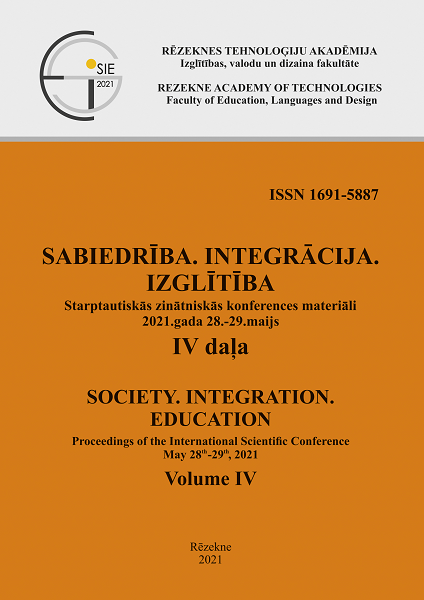THE INFLUENCE OF BOXING EXERCISES ON THE COGNITIVE PROCESSES AND SPEED OF SENSORIMOTOR REACTIONS OF 15-17 YEARS OLD BOYS
DOI:
https://doi.org/10.17770/sie2021vol4.6232Keywords:
boys, boxing, physical education, thought processesAbstract
The article is dedicated to studying of the influence of boxing trainings on thinking processes of the process of physical education and speed of sensorimotor of 15-17 years old boys. The goal of the research is optimization process of the physical education and improvement of the cognitive processes of 15-17 years old boys. The methods of the research are methodological literature analysis, psychophysiological reaction testing, applying computer complex, pedagogical experiment and mathematical statistics methods. It was proved that boxers have better ability to fast reacting (t=2.513 with p<0.05), higher indicators of functional level of central nervous system (t=3.165 with p<0.05), stability of reaction (t=2.248 with p<0.05), better indicators of average reaction time with sound and visual interferences (t=3.104 with p<0.05), better indicators of attention capacity (t=2.317) with p<0.05). Attention diversification (t=2.793 with p<0.05), that prove positive impact of boxing exercises on the thinking processes. There was implemented author program, applying no-contact special boxing exercises. There were 30 students, 15-17 years old, in the experiment. The indicators of the average time of the reaction (Wilcoxon criteria T.emp.=144 with p<0.05) and stability of reaction (Wilcoxon criteria T.emp.=133 with p<0.05) become better after the experiment. Other indicators like indicators of average reaction time with sound and visual interferences (Wilcoxon criteriaT.emp.=112 with p<0.05), indicators of attention capacity (Wilcoxon criteriaT.emp.=61.5 with p<0.05) and indicators of attention diversification (Wilcoxon criteriaT.emp.=7 with p<0.05) become better as well. The conclusions are: the results of the research prove the effectiveness of the experimental program.
References
Bianco,V., Russo, F., Perri, R., & Berchicci, M. (2017). Different proactive and reactive action control in fencers’ and boxers’ brain. Elsevier-Neuroscience, 343, 260–268. DOI: https://doi.org/10.1016/j.neuroscience.2016.12.006.
Bodnar, I., Dukh, T., Vovkanych, L., & Kindzer, B. (2012).Shvydkist sensomotornykh reaktsii ta kohnityvnykh protsesiv u studentiv vyshchykh navchalnykh zakladiv humanitarnykh spetsialnostei. Fizychna aktyvnist, zdoroviai sport, 4(10), 3–9. Retrieved from: http://repository.ldufk.edu.ua/handle/34606048/5976.
Bodnar, I., Rymar, O., Solovei, A., Malanchuk, H., & Datskiv, P. (2015).Obiektyvni kryterii dlia vyznachennia funktsionalno-rezervnykh mozhlyvostei uchniv serednoho shkilnoho viku. Pedahohika, psykholohiia ta medyko-biolohichni problem fizychnoho vykhovannia i sportu, 11, 11–19. Retrieved from: https://www.sportpedagogy.org.ua/html/journal/201511/PP201511.pdf#page=12.
Brychta, P., Hojka, V., Heller, J., & Ruda, T.(2013). A comparison of reaction times of boys and girls aged 10-11 and 14-15 years. Trends in Sport Sciences, 20 (3), 147–152. Retrieved from: https://www.wbc.poznan.pl/dlibra/publication/387185/edition/299310?language=pl#description.
Computer system of emergency-psychotest. (2016). Retrieved from: https://neurosoft.com/ru/catalog/psycho/expert.
Dudnik, O., Miroshnichenko, V., Kostynska, O., & Kuzmik, V. (2019).Vplyv intelektualnykh vprav na pokaznyky shvydkosti i pryiniattia taktychnykh rishen bokseramy 11-12 rokiv. Fizychna kultura, sport ta zdorovia natsii: zbirnyk naukovykh prats, 7(26), 170–174. Retrieved from:https://93.183.203.244:80/xmlui/handle.
Heppe, H., Kohler, A., & Fleddermann, M. (2016). The Relationship between Expertise in Sports, Visuospatial, and Basic Cognitive Skills. Front. Psychol., 1–14. DOI: https://doi.org/10.3389/fpsyg.2016.00904.
Nikitenko, S. (2019). Pidhotovka bokseriv-pochatkivtsiv u vyshchomu navchalnomu zakladi. Navchalno-metodychnyi posibnyk., 91. Retrieved from: http://repository.ldufk.edu.ua/handle/34606048/23442.
Novokshonov, I., Solovei, A., Yaroshyk, M., & Rymar, O. (2019). Udoskonalennia koordynatsiinykh zdibnostei uchniv starshykh klasiv zasobamy boksu. Visnyk Prykarpatskoho universytetu. Seriia: Fizychna kultura, 33, 67–73. Retrieved from: http://repository.ldufk.edu.ua/bitstream/34606048/22391/1/Untitled.FR12.pdf.
Obmiński, Z., Mroczkowska, H., Kownacka, I., & Stabno, J. (2011). Personality traits and eye-hand coordination in less- and more succesful young male boxers. Journal of Combat Sports and Martial Arts, 2 (2), 83–89. Retrieved from: https://journals.indexcopernicus.com/search/article?articleId=20090.
Pic, М., & Jonsson, G. (2021) Professional Boxing Analysis with T-Patterns. Elsevier-Neuroscience, 232, 113329. DOI: http://doi.org/10.1016/j.physbeh.2021.113329.
Solovei, A. (2002). Spetsialni sylovi yakosti dziudoistiv ta yikh rozvytok na etapi spetsializovanoi bazovoi pidhotovky. Avtoreferat kandydatska dysertatsiia Lviv, LDIFK, 20. Retrieved from: http://repository.ldufk.edu.ua/bitstream/34606048/2382/1/solovey_a_v.PDF.
Solovei, A., & Rymar, O. (2013). Osoblyvosti zastosuvannia zasobiv atletyzmu v fizkulturno-ozdorovchykh zaniattiakh zi studentamy vyshchykh navchalnykh zakladiv. Fizychna aktyvnist, zdoroviai sport, 4(14), 73–78. Retrieved from: http://sportscience.ldufk.edu.ua/index.php/fazis/article/view/179/172.
Vovkanych, L., Dunets-Lesko, A., Penchuk, A., & Kachmar, P. (2015). Osoblyvosti sensomotornykh reaktsii sportsmeniv riznykh sportyvnykh spetsializatsii. Fizychna aktyvnist, zdoroviai sport, 2, 17–26. Retrieved from: http://repository.ldufk.edu.ua/handle/34606048/5848.






